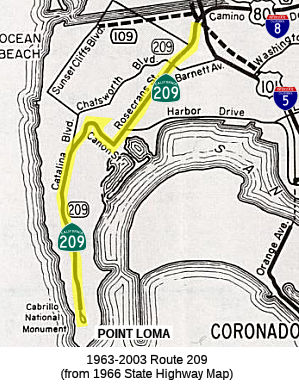

Click here for a key to the symbols used. An explanation of acronyms may be found at the bottom of the page.
 Routing
Routing No current routing.
No current routing.
 Post 1964 Signage History
Post 1964 Signage History In 1963, Route 209 was defined as "Point Loma to Route 5 in San
Diego."
In 1963, Route 209 was defined as "Point Loma to Route 5 in San
Diego."
In 2003, Chapter 525 deleted Route 209.
At one time, the segment to Barnett Street was proposed as a freeway.
 Pre 1964 Signage History
Pre 1964 Signage HistoryThis was originally part of LRN 12, and was signed as part of US 80. It was defined in 1933.
There is a debate on whether US 80 continued W from San Diego to Point
Loma (note that this is not the current I-8 routing W of I-5 to Ocean
Beach). As originally defined, US 80 terminated in "San Diego" via LRN 12
and the Old Spanish Trail. The termination point was imprecise, and was
generally assumed to be at US 101. At the time of definition, this was
sufficient as the state could not maintain highways within large urban
areas. The 1930 state highway map inferred that the route terminated in
downtown San Diego at US 101/Broadway via 4th Street. In 1931, San Diego
County was advocating for US 80 to terminate in Point Loma (making the
highway truly coast to coast). In 1933, when the state could take over
highways in large cities, LRN 12 was extended to Point Loma: "Atlantic
Street, San Diego to old Spanish Lighthouse, Point Loma". On July 16,
1934, the modernized highway carrying LRN 12 to Point Loma was dedicated
and ended at the Old Spanish Lighthouse parking area. This segment was
larger Route 209. However, although some commercial maps showed US 80 as
extended to Point Loma, no state highway maps included that extension.
Throughout the 1930s and 1940s, according to state highway maps, US 80
terminated at US 101. The first reference of US 80 terminating at Point
Loma was in the July/August 1955 California Highways & Public Works,
which refers to Rosecrans Boulevard/LRN 12 between Lytton Street and
Pacific Highway as part of US 80. Additionally, the November/December 1958
California Highways & Public Works specifically states US 80 ended at
the Old Spanish Lighthouse at Point Loma. However, there appears to
be no formal request of AASHO (although it is likely that "San Diego" was
close enough for government work). Muddying the waters is the fact that
the May/June 1961 California Highways & Public Works describes the
freeway corridor of US 80 as ending at US 101. Additionally, when
Route 209 was created in 1964 for the portion of LRN 12 W of US 101, the
1964 Division of Highways Map depicted Route 209 as ending at Point Loma,
but the map does not clearly convey the status of US 80 beyond US 101 (the
1964 map still showed the US highways). In 1966, AASHO approved a
request by the DOH to truncate US 80 to the Arizona State Line. The
DOH Map submitted with the request depicted US 80 terminating at Point
Loma. The specific status remains unclear.
(Source: Gribblenation Blog (Tom Fearer), "US Route 80 to Point Loma?", July 2022)
 Status
StatusThe Gate at the Fort Rosecrans Military Reservation is open daily from 8:00am to 5:15pm. As signs get replaced on I-5, references to Route 209 are disappearing; however, Route 209 is still well marked upon Rosecrans.
 Other WWW Links
Other WWW Links Scenic Route
Scenic Route[SHC 263.1] Entire route.
 Statistics
StatisticsOverall statistics for Route 209:
 Pre-1964 Legislative Route
Pre-1964 Legislative RouteIn 1939, Chapter 794 added the route “[LRN 3] near Station 398, according to the survey of said [LRN 3], Section B, to Shasta Summit near Summit City”. No route number was assigned. This route was added as an urgency measure, in order to accomodate heavy traffic from US 99 to and from Shasta Dam.
In 1943, Chapter 964 amended the 1939 definition to specify this as LRN 209.
In 1953, Chapter 1836 rewrote the routing: "[LRN 3] near Project City to Shasta Dam"
This is present-day Route 151.
© 1996-2020 Daniel P. Faigin.
Maintained by: Daniel P. Faigin
<webmaster@cahighways.org>.